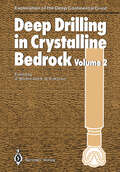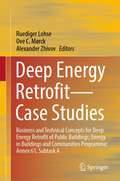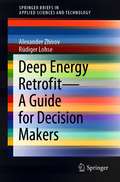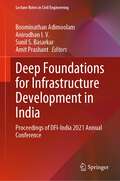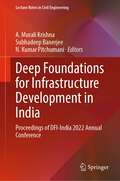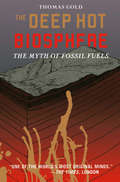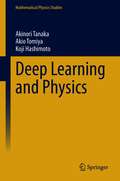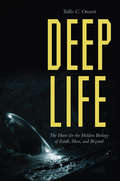- Table View
- List View
Deconstructing Derrida: Tasks for the New Humanities
by M. Peters P. TrifonasResponding to Jacques Derrida's vision for what a 'new' humanities should strive toward, Peter Trifonas and Michael Peters gather together in a single volume original essays by major scholars in the humanities today. Using Derrida's seven programmatic theses as a springboard, the contributors aim to reimagine, as Derrida did, the tasks for the new humanities in such areas as history of literature, history of democracy, history of profession, idea of sovereignty, and history of man. Deconstructing Derrida engages Jacques Derrida's polemic on the future of the humanities to come and expands on the notion of what us proper to the humanities in the current age of globalism and change.
Deconstructing Olduvai: A Taphonomic Study of the Bed I Sites (Vertebrate Paleobiology and Paleoanthropology)
by Manuel Domínguez-Rodrigo Rebeca Barba Charles P. EgelandThe Olduvai Bed I archaeological sites have been at the epicenter of the debate on how early humans behaved. This book presents a new analytical approach that has produced unexpected results: the association of stone tools and faunal remains at most Olduvai Bed I sites is accidental and not related to hominid behavior. This revolutionary analysis shows that current models of reconstruction of human behavior are wrong.
Decorrelative Mollifier Gravimetry: Basics, Ideas, Concepts, and Examples (Geosystems Mathematics)
by Willi FreedenThis monograph presents the geoscientific context arising in decorrelative gravitational exploration to determine the mass density distribution inside the Earth. First, an insight into the current state of research is given by reducing gravimetry to mathematically accessible, and thus calculable, decorrelated models. In this way, the various unresolved questions and problems of gravimetry are made available to a broad scientific audience and the exploration industry. New theoretical developments will be given, and innovative ways of modeling geologic layers and faults by mollifier regularization techniques are shown.This book is dedicated to surface as well as volume geology with potential data primarily of terrestrial origin. For deep geology, the geomathematical decorrelation methods are to be designed in such a way that depth information (e.g., in boreholes) may be canonically entered. Bridging several different geo-disciplines, this book leads in a cycle from the potential measurements made by geoengineers, to the cleansing of data by geophysicists and geoengineers, to the subsequent theory and model formation, computer-based implementation, and numerical calculation and simulations made by geomathematicians, to interpretation by geologists, and, if necessary, back. It therefore spans the spectrum from geoengineering, especially geodesy, via geophysics to geomathematics and geology, and back.Using the German Saarland area for methodological tests, important new fields of application are opened, particularly for regions with mining-related cavities or dense development in today's geo-exploration.
Decoupling Control (Lecture Notes in Control and Information Sciences #285)
by Qing-Guo WangDecoupling or non-interactive control has attracted considerable research attention since the 1960s when control engineers started to deal with multivariable systems. The theory and design techniques for decoupling control have now, more or less matured for linear time-invariant systems, yet there is no single book which focuses on such an important topic. The present monograph fills this gap by presenting a fairly comprehensive and detailed treatment of decoupling theory and relevant design methods. Decoupling control under the framework of polynomial transfer function and frequency response settings, is included as well as the disturbance decoupling problem. The emphasis here is on special or relatively new compensation schemes such as (true and virtual) feedforward control and disturbance observers, rather than use of feedback control alone. The results are presented in a self-contained way and only the knowledge of basic linear systems theory is assumed of the reader.
The Deep: The Hidden Wonders of Our Oceans and How We Can Protect Them
by Alex Rogers'[An] authoritative, hands-on study' NatureFrom one of the world's pre-eminent marine biologists comes a dazzling account of the wonders that lie beneath the ocean's surface, and an empowering vision of how we can protect themFewer people have been to the deepest part of the ocean than have been to the moon. Even now, the vast majority of this wilderness - which covers over 70% of the planet and forms its largest ecosystem - has never been seen by human eyes, let alone explored or investigated by scientists. Yet our oceans contain perhaps 90% of all life, and the physical and biological processes within it are critical to supporting our existence on Earth.Professor Alex Rogers has spent the past 30 years studying life in the deep ocean. In this book, he takes us on an epic and utterly unforgettable voyage to an alien world, and brings us right to the edge of what is known about our oceans today. Introducing us to glittering coral gardens, submarine mountains and a range of bizarre and breathtaking sea creatures, many of which he discovered first-hand, Rogers not only illustrates the ocean's enormous and untold impact on our lives, but also shows how we are damaging it catastrophically through pollution, overfishing, and the insidious and global effects of climate change.Imbued with the author's infectious sense of wonder, and replete with stunning photography of underwater life, The Deep is a magisterial study of a world we are only just beginning to understand - and a profoundly hopeful call to arms for us to reshape our relationship with it, before it is too late.
Deep-Buried Large Hydrocarbon Fields Onshore China: Formation and Distribution
by Suyun Hu Tongshan WangThis book analyzes the formation and evolution of the giant hydrocarbon reservoirs based on major basins onshore China. It discusses exploration and research advantages of major basins in China, such as Sichuan, Tarim, and Ordos Basins and also systematically analyzes and summarizes the formation conditions, distribution rules, and main controlling factors of deep oil and gas fields. On this basis, it forecasts the exploration prospect of China's onshore deep oil and gas, providing theoretical guidance and technical support for deep oil and gas exploration breakthrough and large-scale reserves growth. This book focuses on the analysis and discussion of hydrocarbon generation mechanism of deep-paleo source rocks, discusses the accumulation rules of cross-structural reservoir formation and oil-gas enrichment in ancient strata, the combination of gypsum-salt rocks and carbonate rocks, the potential of oil and gas accumulation under salt, the main controlling factors and distribution rules of deep oil and gas fields, and preliminarily grasps the geological understanding of the formation and distribution of deep-large oil and gas fields, namely ①abundant hydrocarbon supplied by two types of source kitchens, ②three large-scale lithologic reservoir rocks, ③hydrocarbon accumulation controlled by three paleoes (paleouplift, paleoplatform margin, and paleofaults), and ④reservoir formation across major tectonic periods. The book serves as a guidance for both researchers and students majoring in petroleum geology and other related fields.
Deep Crustal Structure of the Son-Narmada-Tapti Lineament, Central India (Springer Theses)
by G. Dhanunjaya NaiduWith a length of about 1200 km, the Son-Narmada-Tapti Lineament (NSL) is one of the most prominent geomorphic features in the Indian subcontinent. Anomalous conductive bodies are delineated at mid-lower crustal depths below major earthquake epicentral zones. The region has been interpreted as the collision zone of the Indian Plate with the Eurasian Plate. The NSL zone is therefore also known to be the second most important tectonic feature in the Indian geology, after the Himalayas. The present thesis describes significant new insight into the seismotectonics of this Central India tectonic zone, based on thorough magnetotelluric studies. The main objectives of the present study are: (i) to delineate subtrappean sediments across the NSL region along four different traverses, (ii) to understand the characterization of geo-electrical structure of the crust and examine the nature of geo-electrical signatures of the known faults, (iii) to integrate the results with other geophysical data such as seismicity, gravity and heat flow, in order to understand the tectonic scenario of the region. Deep electromagnetic (magnetotelluric) analyses were integrated in this study with gravity, seismic and heat flow studies and distinct, delineated deep crustal features. The resulting high conductivity is justified with the presence of fluids at mid-lower crustal depths. The migration of these fluids from mantle to mid-lower crustal depths through pre-existing brittle fracture/fault zones were obviously caused by the plume related to the Deccan volcanism. Migration of the fluids generated a higher fluid pressure along the faults and resulted in earthquakes. Based on the geo-electric sections derived along the four traverses of the Narmada-Son Lineament Zone, the present study gives important clues on the subduction/collision history in this important tectonic zone.
Deep Drilling in Crystalline Bedrock: Volume 2: Review of Deep Drilling Projects, Technology, Sciences and Prospects for the Future (Exploration of the Deep Continental Crust)
by A. Boden K. G. ErikssonDeep Earth: Physics and Chemistry of the Lower Mantle and Core (Geophysical Monograph Series #217)
by Hidenori Terasaki Rebecca A. FischerDeep Earth: Physics and Chemistry of the Lower Mantle and Core highlights recent advances and the latest views of the deep Earth from theoretical, experimental, and observational approaches and offers insight into future research directions on the deep Earth. In recent years, we have just reached a stage where we can perform measurements at the conditions of the center part of the Earth using state-of-the-art techniques, and many reports on the physical and chemical properties of the deep Earth have come out very recently. Novel theoretical models have been complementary to this breakthrough. These new inputs enable us to compare directly with results of precise geophysical and geochemical observations. This volume highlights the recent significant advancements in our understanding of the deep Earth that have occurred as a result, including contributions from mineral/rock physics, geophysics, and geochemistry that relate to the topics of: I. Thermal structure of the lower mantle and core II. Structure, anisotropy, and plasticity of deep Earth materials III. Physical properties of the deep interior IV. Chemistry and phase relations in the lower mantle and core V. Volatiles in the deep Earth The volume will be a valuable resource for researchers and students who study the Earth's interior. The topics of this volume are multidisciplinary, and therefore will be useful to students from a wide variety of fields in the Earth Sciences.
Deep Earth: Physics and Chemistry of the Lower Mantle and Core (Geophysical Monograph Series #217)
by Hidenori Terasaki Terasaki Rebecca A. FischerDeep Earth: Physics and Chemistry of the Lower Mantle and Core highlights recent advances and the latest views of the deep Earth from theoretical, experimental, and observational approaches and offers insight into future research directions on the deep Earth. In recent years, we have just reached a stage where we can perform measurements at the conditions of the center part of the Earth using state-of-the-art techniques, and many reports on the physical and chemical properties of the deep Earth have come out very recently. Novel theoretical models have been complementary to this breakthrough. These new inputs enable us to compare directly with results of precise geophysical and geochemical observations. This volume highlights the recent significant advancements in our understanding of the deep Earth that have occurred as a result, including contributions from mineral/rock physics, geophysics, and geochemistry that relate to the topics of: I. Thermal structure of the lower mantle and core II. Structure, anisotropy, and plasticity of deep Earth materials III. Physical properties of the deep interior IV. Chemistry and phase relations in the lower mantle and core V. Volatiles in the deep Earth The volume will be a valuable resource for researchers and students who study the Earth's interior. The topics of this volume are multidisciplinary, and therefore will be useful to students from a wide variety of fields in the Earth Sciences.
Deep Energy Retrofit: A Guide to Achieving Significant Energy Use Reduction with Major Renovation Projects (Springerbriefs In Applied Sciences And Technology Ser.)
by Alexander Zhivov Rüdiger LohseThis book provides detailed information on how to set up Deep Energy Retrofits (DERs) in public buildings, and shares in-depth insights into the current status of the major technologies, strategies and best practice examples of how to cost-effectively combine them. Case studies from the U.S.A. and Europe show that that Deep Energy Retrofit can be achieved with a limited core technologies bundle readily available on the market. Characteristics of some of these core technology measures depend on the technologies available on an individual nation’s market, on the minimum requirements of national standards, and on economics (as determined by a life cycle cost analysis). Also, requirements to building envelope-related technologies (e.g., insulation levels, windows, vapor and water barriers, and requirements for building airtightness) depend on specific climate conditions. This Guide provides best practice examples of how to apply these technologies in different construction situations.High levels of energy use reduction using core technology bundles along with improvements in indoor climate and thermal comfort can be only achieved when a Deep Energy Retrofit adopts a quality assurance process. In addition to design, construction, commissioning, and post-occupancy phases of the quality assurance process, the Guide emphasizes the importance of clearly and concisely formulating and documenting the Owner’s goals, expectations, and requirements for the renovated building during development of the statement of work. Another important component of the quality assurance process is a procurement phase, during which bidders’ qualifications, their understanding of the scope of work and its requirements, and their previous experience are analyzed.The building sector holds the potential for tremendous improvements in terms of energy efficiency and reducing carbon emissions, and energy retrofits to the existing building stock represent a significant opportunity in the transition to a low-carbon future. Moreover, investing in highly efficient building materials and systems can replace long-term energy imports, contribute to cost cutting, and create a wealth of new jobs. Yet, while the technologies needed in order to improve energy efficiency are readily available, significant progress has not yet been made, and “best practices” for implementing building technologies and renewable energy sources are still relegated to small “niche” applications.Offering essential information on Deep Energy Retrofits, the book offers a valuable asset for architects, public authorities, project developers, and engineers alike.
Deep Energy Retrofit Guide for Public Buildings: Business and Financial Models (SpringerBriefs in Applied Sciences and Technology)
by Rüdiger Lohse Alexander ZhivovThis book provides detailed information on how to set up Deep Energy Retrofits (DERs) in public buildings, and shares in-depth insights into the current status of the major technologies, strategies and practical best practice examples of how to cost-effectively combine them. Case studies from Europe are analyzed with respect to energy use before and after renovation, reasons for undertaking the renovation, co-benefits achieved, resulting cost-effectiveness, and the business models employed. The building sector holds the potential for tremendous improvements in terms of energy efficiency and reducing carbon emissions, and energy retrofits to the existing building stock represent a significant opportunity in the transition to a low-carbon future. Moreover, investing in highly efficient building materials and systems can replace long-term energy imports, contribute to cost cutting, and create a wealth of new jobs. Yet, while the technologies needed in order to improve energy efficiency are readily available, significant progress has not yet been made, and “best practices” for implementing building technologies and renewable energy sources are still relegated to small “niche” applications. Offering essential information on Deep Energy Retrofits, the book offers a valuable asset for architects, public authorities, project developers, and engineers alike.
Deep Energy Retrofit—Case Studies: Business and Technical Concepts for Deep Energy Retrofit of Public Buildings; Energy in Buildings and Communities Programme; Annex 61, Subtask A
by Ruediger Lohse Ove C. Mørck Alexander ZhivovThis book describes results of research conducted with the goal of providing a framework, selected tools, and guidelines to significantly reduce energy use (by more than 50%) in government and public buildings. The scope of the book is limited to public buildings that were constructed before the 1980s with low internal loads (e.g., office buildings, dormitories, barracks, public housing, and educational buildings) and that were undergoing major renovation. The book contains description and analysis of 26 well-documented case studies from Europe (Austria, Denmark, Estonia, Germany, Ireland, Latvia, Montenegro, The Netherlands, and the UK) and the USA. After these data were collected, the case studies were analyzed with respect to energy use (before and after renovation), reasons for undertaking the renovation, co-benefits achieved, resulting cost-effectiveness, and the business models followed. Finally, “lessons learned” were compiled and compared.Deep Energy Retrofit (DER) is a major building renovation project in which site energy use intensity (including plug loads) has been reduced by at least 50% from the pre-renovation baseline with a corresponding improvement in indoor environmental quality and comfort. Lessons learned from the case studies and experiences of the team clearly indicate that DER can be achieved with the application of “bundles” of a limited number of core technologies readily available on the market. Specific characteristics of some of these core technology bundles generally depend on the technologies available on an individual nation’s market, on the minimum requirements of national standards, and on economics (as determined by a life cycle cost [LCC] analysis).
Deep Energy Retrofit—A Guide for Decision Makers (SpringerBriefs in Applied Sciences and Technology)
by Alexander Zhivov Rüdiger LohseMany governments worldwide are setting more stringent targets for reductions in energy use in government/public buildings. Buildings constructed more than 10 years ago account for a major share of energy used by the building stock. However, the funding and “know-how” (applied knowledge) available for owner-directed energy retrofit projects has not kept pace with new requirements. With typical retrofit projects, reduction of energy use varies between 10 and 20%, while actual executed renovation projects show that energy use reduction can exceed 50%, and can cost-effectively achieve the Passive House standard or even approach net zero-energy status (EBC Annex 61 2017a, Hermelink and Müller 2010; NBI 2014; RICS 2013; Shonder and Nasseri 2015; Miller and Higgins 2015; Emmerich et al. 2011).Building energy efficiency (EE) ranks first in approaches with resource efficiency potential with a total resource benefit of approximately $700 billion until 2030. EE is by far the cheapest way to cut CO2 emissions (McKinsey 2011, IPCC 2007). However, according to an IEA study (IEA 2014a), more than 80% of savings potential in building sector remains untapped. Thus, the share of deployed EE in the building sector is lower than in the Industry, Transport, and Energy generation sectors. Estimates for the deep renovation potentials show: €600-900bn investment potential, €1000-1300bn savings potential, 70% energy-saving potential, and 90% CO2 reduction potential.
Deep Excavations in Soil
by John EndicottThe book describes the theory and current practices for design of earth lateral support for deep excavations in soil. It addresses basic principles of soil mechanics and explains how these principles are embodied in design methods including hand calculations. It then introduces the use of numerical methods including the fundamental “beam on springs” models, and then more sophisticated computer programmes which can model soil as a continuum in two or three dimensions. Constitutive relationships are introduced that are in use for representing the behaviour of soil including a strain hardening model, and a Cam Clay model including groundwater flow and coupled consolidation. These methods are illustrated by reference to practical applications and case histories from the author’s direct experience, and some of the pitfalls that can occur are discussed. Theory and design are strongly tied to construction practice, with emphasis on monitoring the retaining structures and movement of surrounding ground and structures, in the context of safety and the Observational Method. Examples are presented for conventional “Bottom-up” and “Top-down” sequences, along with hybrid sequences giving tips on how to optimise the design and effect economies of cost and time for construction. It is written for practising geotechnical, civil and structural engineers, and especially for senior and MSc students.
Deep Excavations in Soil
by John EndicottThe book describes the theory and current practices for design of earth lateral support for deep excavations in soil. It addresses basic principles of soil mechanics and explains how these principles are embodied in design methods including hand calculations. It then introduces the use of numerical methods including the fundamental “beam on springs” models, and then more sophisticated computer programmes which can model soil as a continuum in two or three dimensions. Constitutive relationships are introduced that are in use for representing the behaviour of soil including a strain hardening model, and a Cam Clay model including groundwater flow and coupled consolidation. These methods are illustrated by reference to practical applications and case histories from the author’s direct experience, and some of the pitfalls that can occur are discussed. Theory and design are strongly tied to construction practice, with emphasis on monitoring the retaining structures and movement of surrounding ground and structures, in the context of safety and the Observational Method. Examples are presented for conventional “Bottom-up” and “Top-down” sequences, along with hybrid sequences giving tips on how to optimise the design and effect economies of cost and time for construction. It is written for practising geotechnical, civil and structural engineers, and especially for senior and MSc students.
Deep Foundations for Infrastructure Development in India: Proceedings of DFI-India 2021 Annual Conference (Lecture Notes in Civil Engineering #315)
by Boominathan Adimoolam Anirudhan I. V. Sunil S. Basarkar Amit PrashantThis book contains select proceedings of the 10th annual conference of Deep Foundations Institute of India, DFI India, 2021. It presents papers on 1) Geotechnical Investigation, Testing, Instrumentation, Monitoring, and Quality Management, 2) Ground Improvement Techniques, 3) Piling and Deep Foundation Techniques, 4) Earth Retention and Deep Excavation Support, 5) Research, Experimental and Numerical Methods in Deep Foundations and Deep Excavation Technologies, and 6) Safe and Efficient Geo-Construction. This book has seventeen articles, each with a specific field application value. The probabilistic approach in evaluating the field data, namely SPT N and pressure meter modulus for arriving at the geotechnical design parameters, multiphase site investigation program for complex underground construction activity, the safety of working platforms in foundation construction projects, usage of liner piles to support the reaction platform for static loading tests for piles, choice of foundation system for three bridges, emphasis on the importance of selecting an appropriate foundation system for the safe and timely completion of the project, challenges in deep excavations, constructions in confined spaces, groundwater level variations, and their influence on tunneling have been discussed. The usefulness of numerical analysis in the design of deep excavations and ground improvement projects is highlighted. The articles covered in this book are of immense value to professionals and academicians for improving their work practice.
Deep Foundations for Infrastructure Development in India: Proceedings of DFI-India 2022 Annual Conference (Lecture Notes in Civil Engineering #373)
by A. Murali Krishna Subhadeep Banerjee N. Kumar PitchumaniThis book comprises select proceedings of the 11th annual conference of Deep Foundations Institute of India, DFI India 2022, held during 15–17 September 2022 in Tirupati. The conference showcased advancements in deep foundation technologies through articles on research and case histories. The book presents papers on deep foundation and deep excavation technologies for metro and high-speed rail; innovative techniques and testing for geotechnical investigations; monitoring, performance, and the QA-QC of deep foundations; challenges to working and the impact of existing codes with respect to technical innovations in deep foundations; ground improvement techniques for mass stabilization; geotechnics for marine, near-shore, and coastal constructions; research, experimental and numerical methods in deep foundations and deep excavation technologies; mono-piles and other advanced deep foundation systems; deep foundations in coralline and carbonate rocks and other unique and interesting papers related to deep foundation themes.
The Deep Hot Biosphere: The Myth of Fossil Fuels
by Thomas GoldThis book sets forth a set of truly controversial and astonishing theories: First, it proposes that below the surface of the earth is a biosphere of greater mass and volume than the biosphere the total sum of living things on our planet's continents and in its oceans. Second, it proposes that the inhabitants of this subterranean biosphere are not plants or animals as we know them, but heat-loving bacteria that survive on a diet consisting solely of hydrocarbons that is, natural gas and petroleum. And third and perhaps most heretically, the book advances the stunning idea that most hydrocarbons on Earth are not the byproduct of biological debris ("fossil fuels"), but were a common constituent of the materials from which the earth itself was formed some 4.5 billion years ago.The implications are astounding. The theory proposes answers to often-asked questions: Is the deep hot biosphere where life originated, and do Mars and other seemingly barren planets contain deep biospheres? Even more provocatively, is it possible that there is an enormous store of hydrocarbons upwelling from deep within the earth that can provide us with abundant supplies of gas and petroleum?However far-fetched these ideas seem, they are supported by a growing body of evidence, and by the indisputable stature and seriousness Gold brings to any scientific debate. In this book we see a brilliant and boldly original thinker, increasingly a rarity in modern science, as he develops potentially revolutionary ideas about how our world works.
Deep Learning and Computational Physics
by Deep Ray Orazio Pinti Assad A. OberaiThe main objective of this book is to introduce a student who is familiar with elementary math concepts to select topics in deep learning. It exploits strong connections between deep learning algorithms and the techniques of computational physics to achieve two important goals. First, it uses concepts from computational physics to develop an understanding of deep learning algorithms. Second, it describes several novel deep learning algorithms for solving challenging problems in computational physics, thereby offering someone who is interested in modeling physical phenomena with a complementary set of tools. It is intended for senior undergraduate and graduate students in science and engineering programs. It is used as a textbook for a course (or a course sequence) for senior-level undergraduate or graduate-level students.
Deep Learning and Physics (Mathematical Physics Studies)
by Akinori Tanaka Akio Tomiya Koji HashimotoWhat is deep learning for those who study physics? Is it completely different from physics? Or is it similar? In recent years, machine learning, including deep learning, has begun to be used in various physics studies. Why is that? Is knowing physics useful in machine learning? Conversely, is knowing machine learning useful in physics? This book is devoted to answers of these questions. Starting with basic ideas of physics, neural networks are derived naturally. And you can learn the concepts of deep learning through the words of physics.In fact, the foundation of machine learning can be attributed to physical concepts. Hamiltonians that determine physical systems characterize various machine learning structures. Statistical physics given by Hamiltonians defines machine learning by neural networks. Furthermore, solving inverse problems in physics through machine learning and generalization essentially provides progress and even revolutions in physics. For these reasons, in recent years interdisciplinary research in machine learning and physics has been expanding dramatically. This book is written for anyone who wants to learn, understand, and apply the relationship between deep learning/machine learning and physics. All that is needed to read this book are the basic concepts in physics: energy and Hamiltonians. The concepts of statistical mechanics and the bracket notation of quantum mechanics, which are explained in columns, are used to explain deep learning frameworks.We encourage you to explore this new active field of machine learning and physics, with this book as a map of the continent to be explored.
Deep Learning for Hydrometeorology and Environmental Science (Water Science and Technology Library #99)
by Taesam Lee Vijay P. Singh Kyung Hwa ChoThis book provides a step-by-step methodology and derivation of deep learning algorithms as Long Short-Term Memory (LSTM) and Convolution Neural Network (CNN), especially for estimating parameters, with back-propagation as well as examples with real datasets of hydrometeorology (e.g. streamflow and temperature) and environmental science (e.g. water quality). Deep learning is known as part of machine learning methodology based on the artificial neural network. Increasing data availability and computing power enhance applications of deep learning to hydrometeorological and environmental fields. However, books that specifically focus on applications to these fields are limited.Most of deep learning books demonstrate theoretical backgrounds and mathematics. However, examples with real data and step-by-step explanations to understand the algorithms in hydrometeorology and environmental science are very rare. This book focuses on the explanation of deep learning techniques and their applications to hydrometeorological and environmental studies with real hydrological and environmental data. This book covers the major deep learning algorithms as Long Short-Term Memory (LSTM) and Convolution Neural Network (CNN) as well as the conventional artificial neural network model.
Deep-Level Gold and Platinum Mining: The Application of Geophysics in South Africa
by Michael van Schoor Zamaswazi Nkosi Fleckson Magweregwede Thabang KgarumeThis book provides the basic know-how and guidance to effectively exploit non-destructive geophysical technologies and apply them in the underground mining environment to optimise mineral extraction and to contribute to safer mining. The effective application of these technologies can enable a better understanding of the unseen orebody and the surrounding rock mass ahead of the mining face; the potential benefits of applying in-mine geophysics is demonstrated through a selection of case studies conducted in deep-level hard rock mines in South Africa. This book also offers valuable insight and training material for students in a variety of relevant mining disciplines like geology, rock engineering, mining engineering, mine planning and mineral resource management.
Deep Life: The Hunt for the Hidden Biology of Earth, Mars, and Beyond
by Tullis C. OnstottDeep Life takes readers to uncharted regions deep beneath Earth's crust in search of life in extreme environments and reveals how astonishing new discoveries by geomicrobiologists are helping the quest to find life in the solar system.Tullis Onstott, named one of the 100 most influential people in America by Time magazine, provides an insider’s look at the pioneering fieldwork that is shining vital new light on Earth’s hidden biology—a thriving subterranean biosphere that scientists once thought to be impossible. Come along on epic descents two miles underground into South African gold mines to experience the challenges that Onstott and his team had to overcome. Join them in their search for microbes in the ancient seabed below the desert floor in the American Southwest, and travel deep beneath the frozen wastelands of the Arctic tundra to discover life as it could exist on Mars.Blending cutting-edge science with thrilling scientific adventure, Deep Life features rare and unusual encounters with exotic life forms, including a bacterium living off radiation and a hermaphroditic troglodytic worm that has changed our understanding of how complex subsurface life can really be. This unforgettable book takes you to the absolute limits of life—the biotic fringe—where today’s scientists hope to discover the very origins of life itself.







